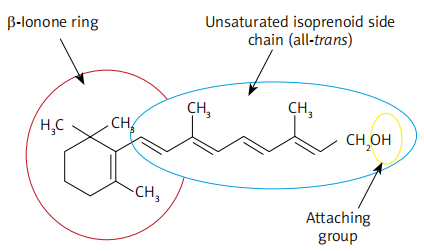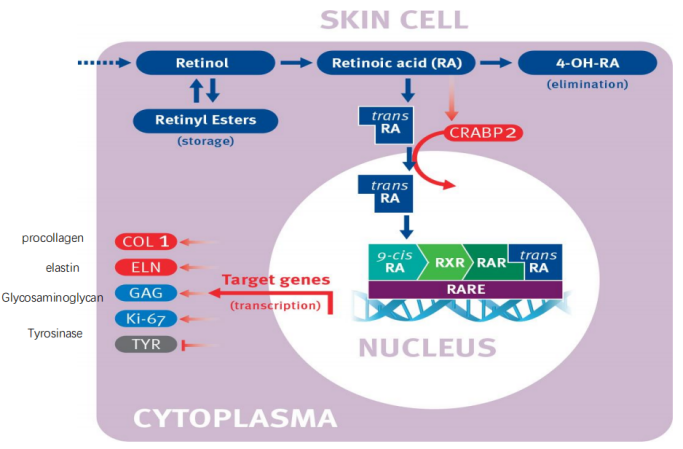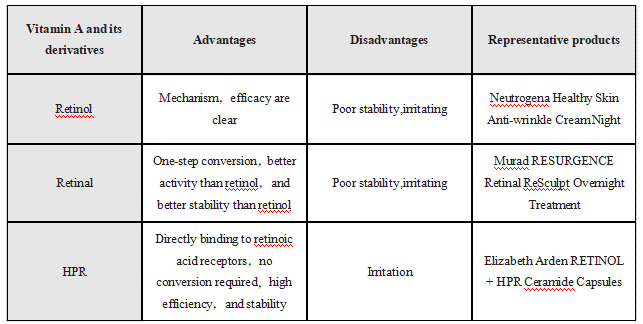Learn About Retinoids
Vitamin A is an oil-soluble vitamin whose molecular structure is composed of 20 carbons, with a β-lonone ring and an unsaturated isoprenoid side chain(all-trans).Different molecules can be formed depending on the different attaching groups at the side chain. Vitamin A, in the broad sense,includes a series of compounds with the above basic structure,also known as retinoids. Vitamin A in the narrow sense refers to retinol.

At present, the global retinoids market in cosmetics is mainly distributed in Asia-Pacific, North America and Europe, with China being the largest market. Retinoids have outstanding performance in the functional skin care market, and with the widespread application of production technology, retinoids still has great market potential.
Retinoids are involved in the process of embryogenesis during development of the nervous system, liver, heart, kidneys, intestine, eyes and limbs. Retinoids are also used in treatment of night blindness,because they are responsible for proper functioning of the organ of sight,and associated with formation of rhodopsin.
Retinoids and their derivatives are substances that effectively slow the aging process. Retinol can penetrate the stratum corneum and it slightly penetrates into the dermis. When retinol reaches a keratinocyte, it will enter cell interior and binds to an appropriate receptor. There are four groups of receptors with high affinity towards retinol (CRBP). Then, retinol regulates the cellular activity of keratinocytes, fibroblasts, melanocytes, and Langerhans cells by interacting with receptors to strengthen the epidermal protective function, reduce TEWL, protect collagen against degradation, and inhibit the activity of metalloproteinases, which are responsible for degradation of the extracellular matrix. Moreover, retinol can enhances remodelling of reticular fibres and stimulates angiogenesis in the papillary layer of the dermis.

However, retinoids need to be converted into retinoic acid first and then bind to retinoic acid receptors (except for HPR). The conversion process is limited by enzyme activity, local delivery, and stability. Moreover, the application of retinoids is often accompanied by the risks of intolerance, phototoxicity, and skin tanning. Although retinoids have outstanding advantages, they still have shortcomings that cannot be ignored in the final product:the formula is unstable, may cause dryness and irritation, and cannot be used during the day.
It is precisely because of the strong stimulating properties of retinoids, coupled with factors such as violent involution and the increasingly rational market, that consumers are more interested in safe and mild retinoids alternative products . So, developing and producing more stable and milder retinoid alternatives has become a new battleground for active ingredients in cosmetics.
As a novel cosmetic active ingredient derived from vitamin A, Anallerg® - Vitamika® not only retains the joint activity of retinoic acid and tocopherol, but also makes it more stable and easier to use in formulations. At the same time, the special structure of Anallerg® - Vitamika® also gives it higher mildness and safety.

l Efficacy comparison (promotes type I collagen production): Vitamika® >HPR>Retinol>Retinyl ester
l Mildness comparison: Vitamika® >Retinyl ester>Retinol>Retinal / HPR
l Thermal stability comparison: Vitamika®>HPR>Retinyl palmitate>Retinyl propionate>Retinal> Retinyl acetate>Retinol
l Photostability comparison: Vitamika®>Retinol or Retinal or HPR>Other Retinyl ester>Retinyl palmitate
